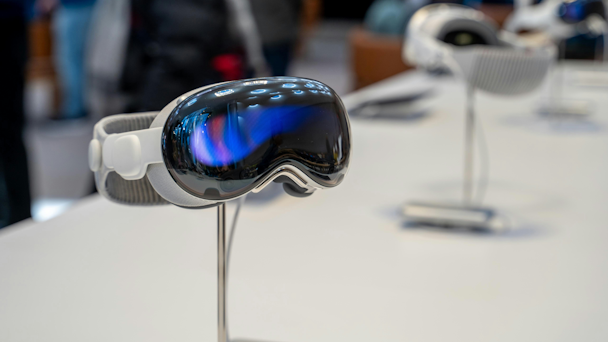The future is (kind of) here: my first week using the Apple Vision Pro
VML’s director of experience design, Luke Hurd, takes us inside his experience of the new Apple Vision Pro.

/ Roméo Arnault
Apologies, I’m not driving a Cybertruck around the Bay Area trying to make a viral video, but I am typing on a virtual desktop, inside of a headset, while I sit peacefully in Joshua Tree (also virtually). Thanks to the recent release of the Apple Vision Pro, my lowly 13-inch work laptop is now a massive 4K display sitting five feet away and, let me tell you, Microsoft Teams has never looked quite this good.
A week into my experience with the device, here are some initial thoughts about where I think the Vision Pro could contribute to the world of marketing and commercial creativity.
‘Buttery smooth’: an experience that outpaces the competition
Advertisement
The Apple Vision Pro was unveiled several months ago but only became available for purchase last Thursday and has completely absorbed my social media feeds. I’ve seen people wearing those glossy goggles while ordering coffee, riding skateboards, taking the subway and even doing the stupidest thing imaginable – driving a car on the streets with other people (please, don’t do this).
While I appreciate the forward-thinking nature of these first adopters, the reality is a bit more subdued: Apple simply didn’t design it to be used like that. This is a sit-in-a-spot-to-create-or-consume-type of device and it does that really, really well. It’s the best 3D movie experience I’ve ever seen and spatial videos recorded with the device are absolutely incredible – even better than spatial videos recorded with the new iPhone 15.
I’ve used almost every head-mounted display (HMD) available on the market for the last six years, from HTC to Meta to Varjo, and I can honestly say that Apple has created some real magic here. It has shattered dozens of barriers of existing HMD experiences – things like in-headset payments (via Apple Pay), file transfers (via AirDrop), music integration (via Apple Music), immersive 3D TV and movies (with Apple+, Disney+, Prime Video, etc) and more.
There are taped-together solutions for these actions in the Meta Quest VR headset, but they are fragmented and not native to the operating system. Plus, Meta frustratingly forces users to share media to Facebook, unless users remove the headset to use the mobile app.
The interactions on the Apple Vision Pro are also unique and quite an experience. Instead of controllers to navigate and operate the device, users gaze and pinch, using their eyes and fingers to select where they’re looking – but they can also simply use their fingers as they would on an iPhone or iPad. Not only can they tap with their fingers, but they can scroll with their fingers, too, and the physics and elasticity of the menus are just like a native iPhone experience.
Advertisement
Plus, with hand and arm segmentation, the user sees their physical hands and arms in the experience at all times, which means they can reach out and touch these virtual windows and buttons.
It’s responsive, easy and, most importantly, a native interaction design for anyone who has used a touch-screen device. To be fair, the Meta Quest operating system also has hand tracking and supports touchable panels and buttons, but it’s quirky and doesn’t work that well. In my experience, I’d find myself searching for my controllers pretty quickly. The Vision Pro, in contrast, is buttery smooth and works just like one would expect – just reach out and touch.
Unlocking new possibilities for marketers
All of these integrations and the focus on ease of use mean that marketers will have a much easier path to connect storytelling – which is already happening in AR and VR – with purchasing, delivery and product demonstrations.
These methods exist right now across other devices, but the support is really weak and the experiences feel disjointed.
Suggested newsletters for you
With Apple focusing so heavily on the user experience of everyday tasks, the Vision Pro is more like a functional laptop than a gaming headset: a really big shift.
Where the Apple Vision Pro falls flat
But it’s not all roses. The device is heavy – slightly heavier than a Quest Pro – and the weight distribution is not ideal for long periods of use. Unlike the Quest Pro, the Vision Pro has all its weight sitting about three inches from the user’s face and the weight is noticeable from the moment it’s picked up. The dual-knit strap does a great job and it’s very comfortable, but weight and physics limitations still apply here – even to the design gods of Apple.
The passthrough – while the best in the industry – is still a video feed and suffers from the same limitations they all do. Things like low-light grittiness and OLED pixel bleed as the user moves are still issues, but this is still the best it has ever been and the passthrough is still quite good. Users will find that their bright rooms look a little dimmer than in reality and the saturation isn’t exact, but I can read my phone and see notifications quite easily (and having my own arms visible means I can always see my watch, too, even in full immersion).
The future is immersive
The Apple Vision Pro isn’t for everyone. As someone much smarter than me said, “This is the worst version of this device they are going to make, so if you can wait, just wait.”
If you don’t want to buy it, my advice is to head to an Apple Store and sit down for a 20-minute demo. You’ll notice the weight, you’ll notice the passthrough issues I described – and then you’ll notice just how amazing this thing feels to use.
Spatial computing (or XR, if you’ve been here a while) is the future revolution of the interface, in the same way the touch screen revolutionized mobile computing by taking a mouse, keyboard and display and cramming them together. This is a glimpse into what the world will be like once we break free of the limitations of two-dimensional width and height and add the boundless third dimension of depth.
I just typed this entire thing out with a headset on, and it was painless. It’s almost a whole new world – and I’m here for it.

